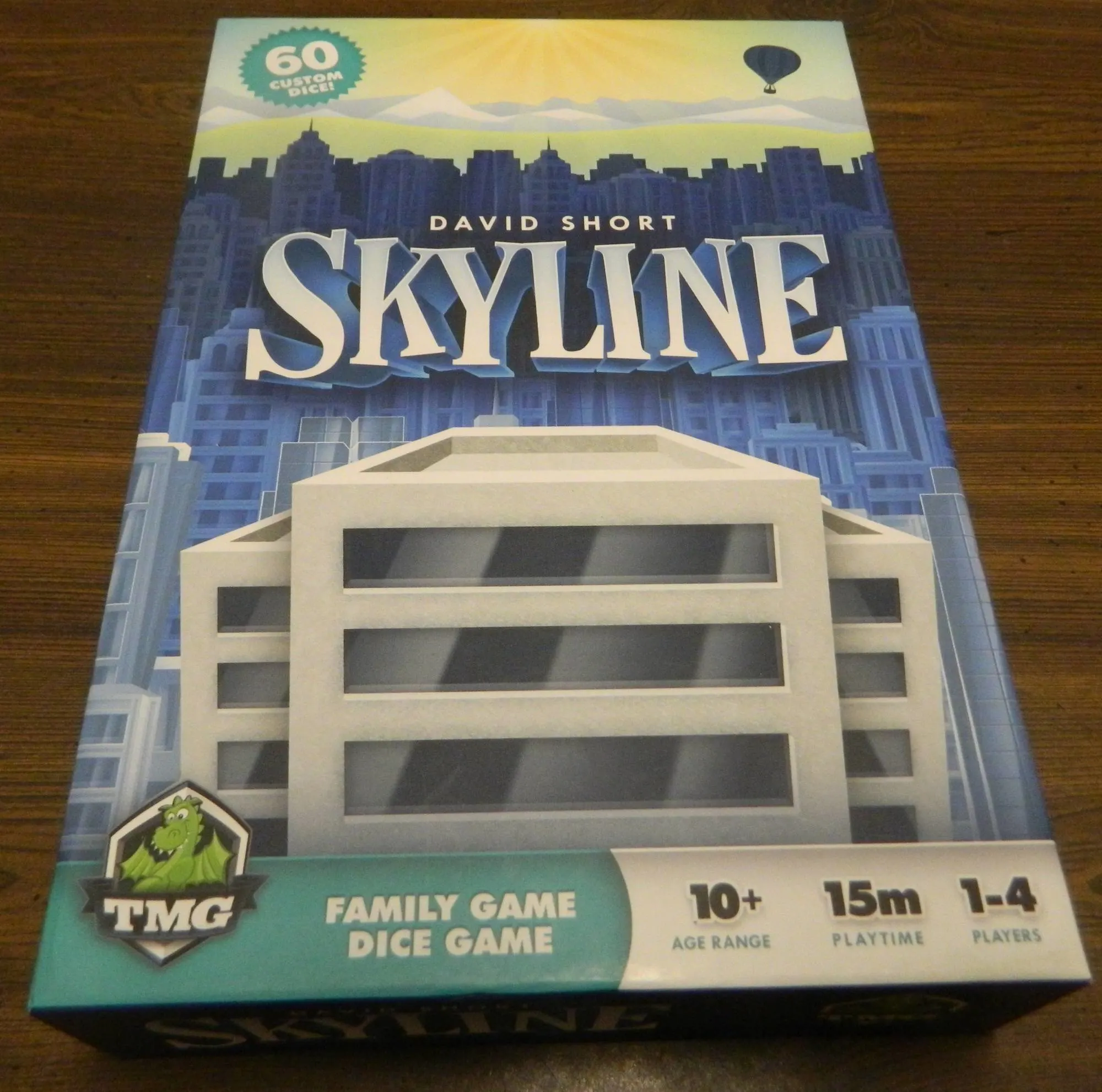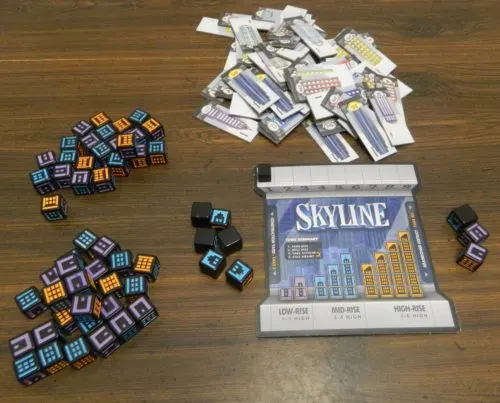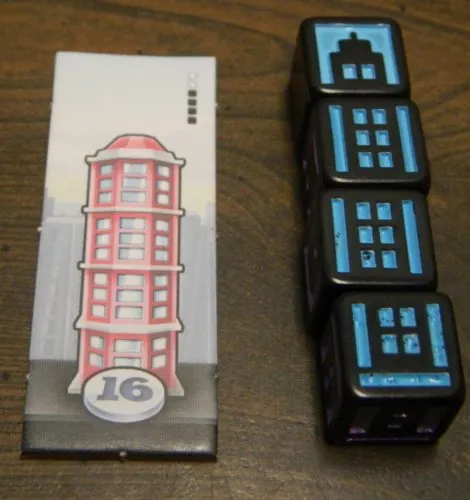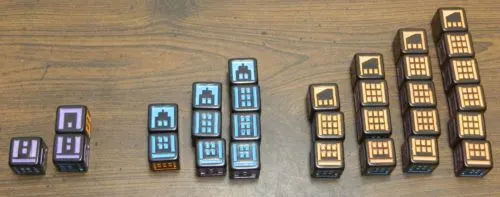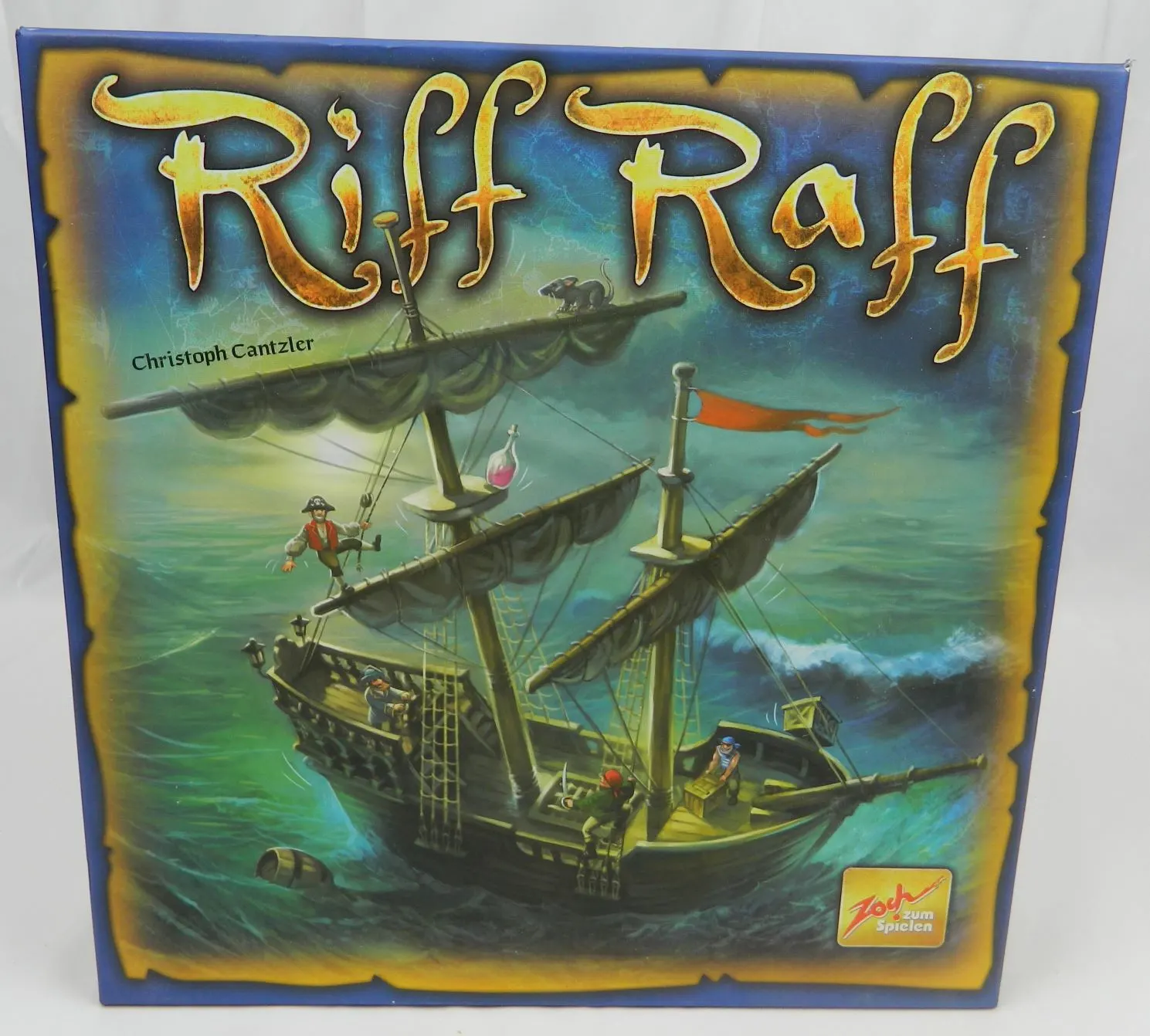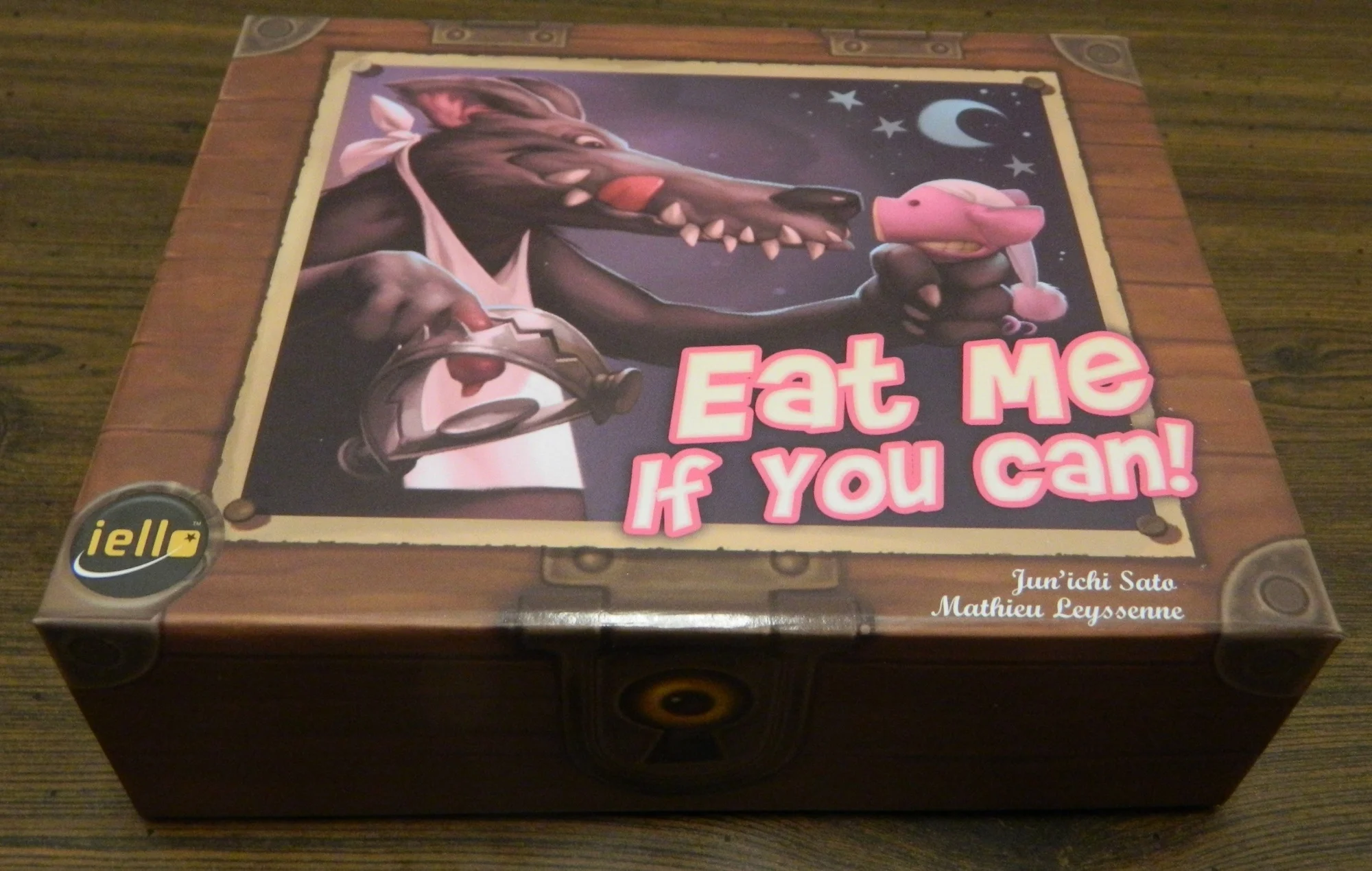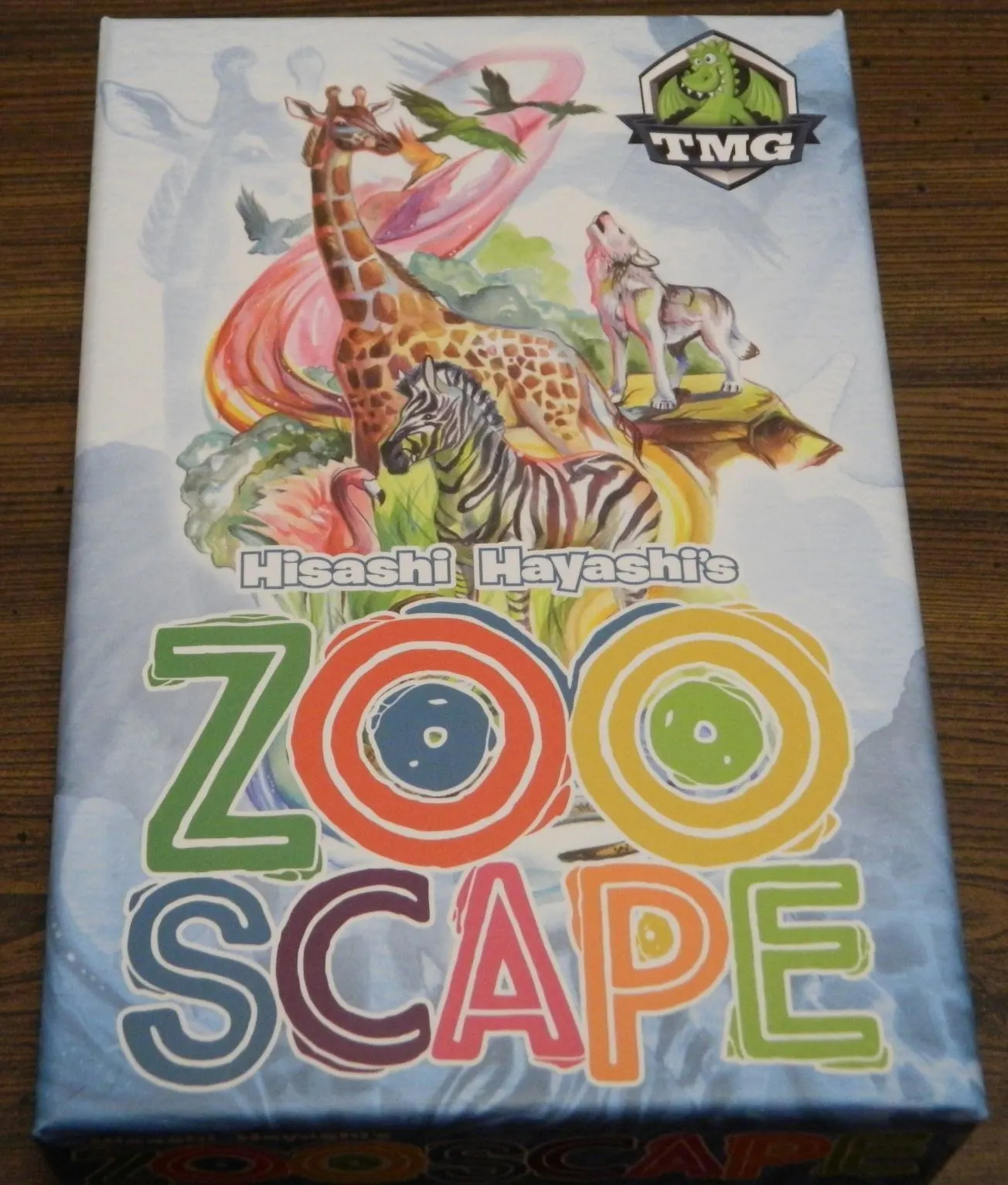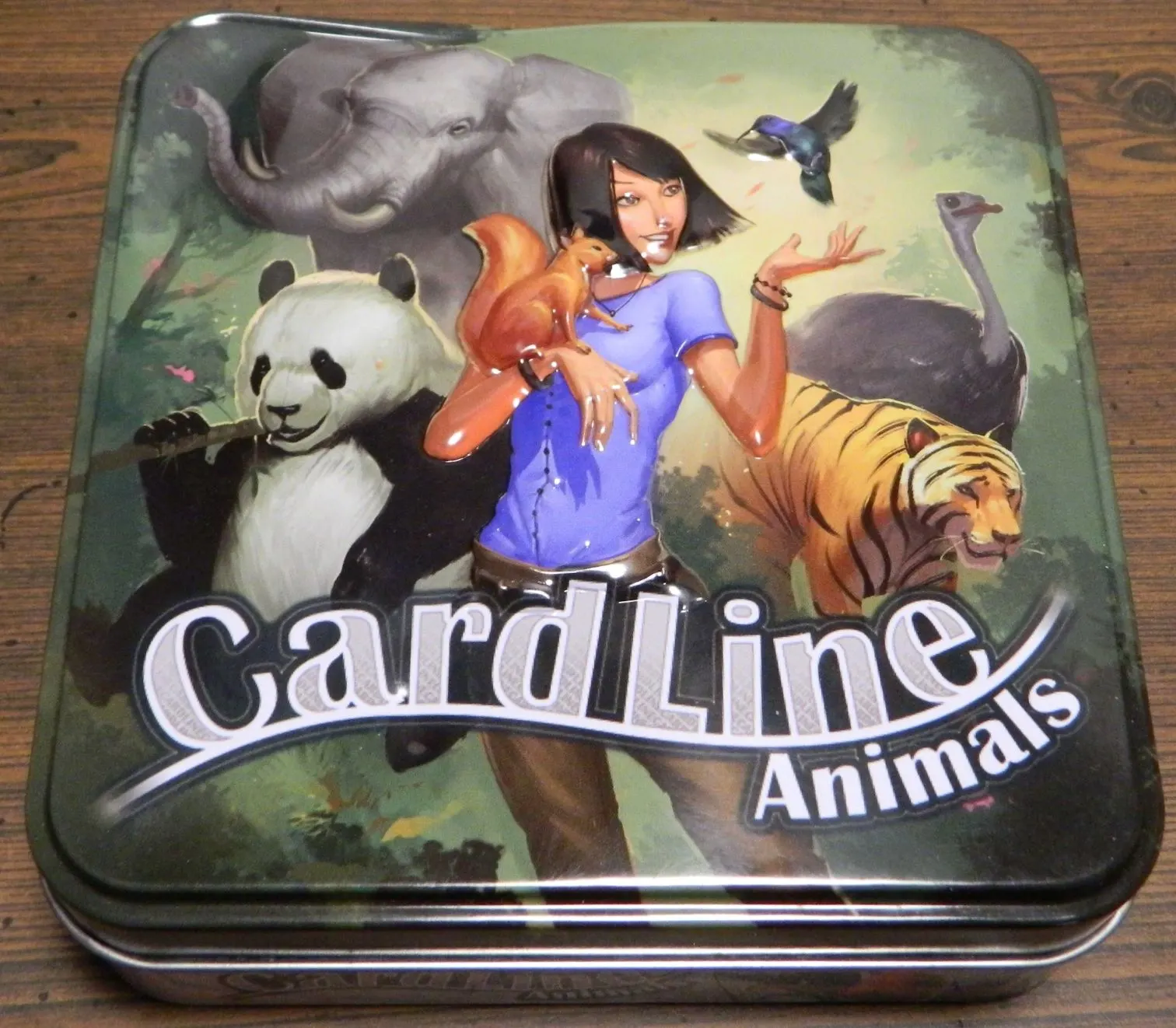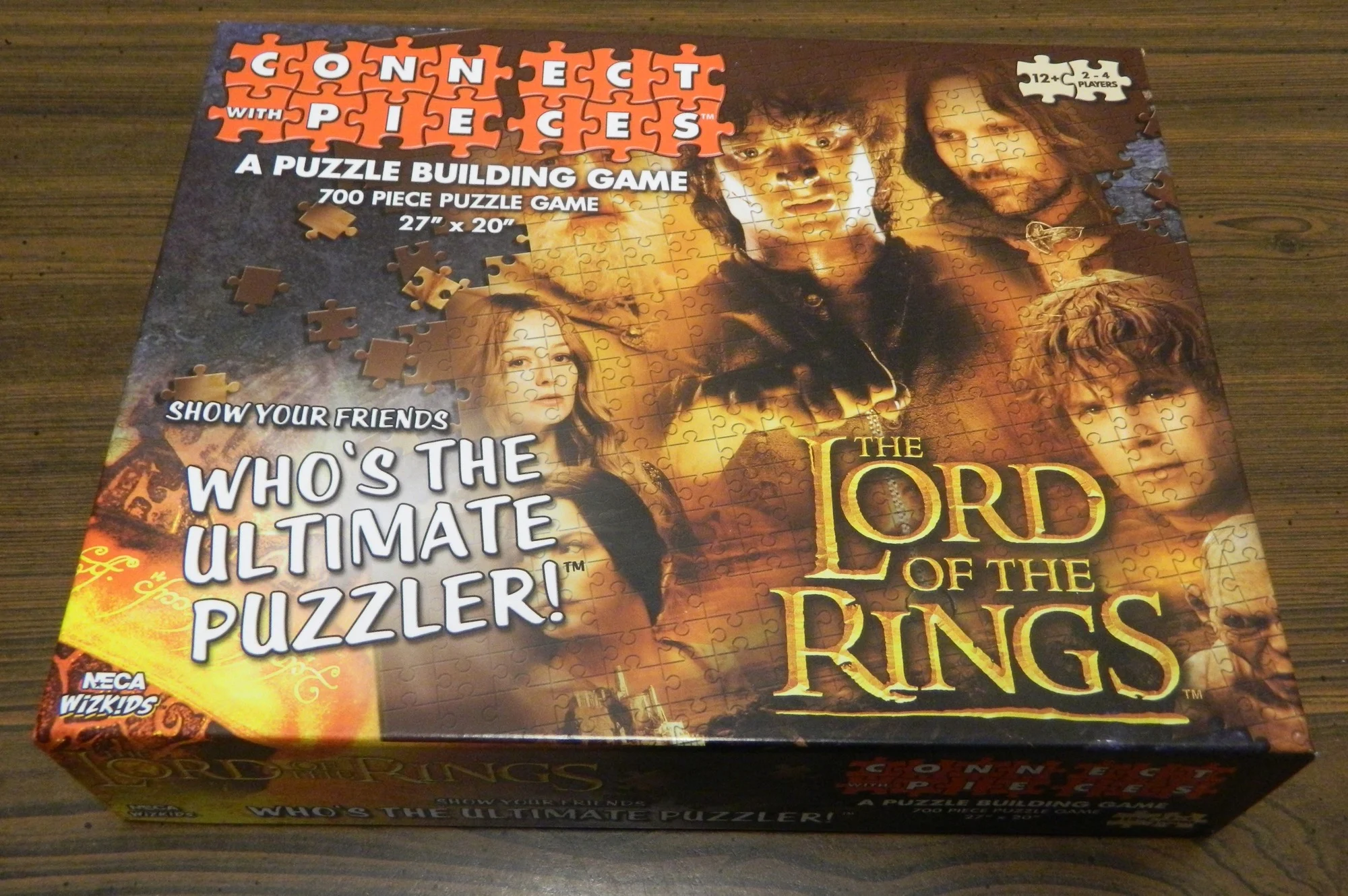Around a year ago we took a look at the dice rolling game Dungeon Roll created by Tasty Minstrel Games. The concept behind Dungeon Roll was to take a dungeon crawler and turn it into a quick and accessible dice rolling game. While I didn’t think the game was perfect I applauded the game for finding a way to successful turn a dungeon crawler into a dice rolling game. Today’s game Skyline, also created by Tasty Minstrel Games, tries to take the city building theme and apply it to a dice rolling game. I have always loved the city builder theme so I was intrigued to see how it would work as a dice rolling game. Skyline succeeds at creating an accessible filler dice rolling game that the whole family can enjoy which might have benefited from being a little longer.
How to Play Skyline
Setup
- Place the status board in the middle of the table. Place the status marker on the one space.
- Place all of the dice to the left of the status board in three piles based on the three different types of dice: ground floor, upper floor, penthouse. These piles are referred to as the construction yard.
- Take one dice of each type and place them to the right of the status board. This pile is known as the abandoned district.
- All of the building tiles should be placed near the status board.
- The player who has most recently been in a high-rise building will start the game.
- Starting with the first player and moving clockwise players will receive one die set to a specific ground floor to start the game. The first player will receive a high-rise/orange ground floor. The second player will receive a mid-rise/blue ground floor. The third player will get a low-rise/purple ground floor. The fourth player receives no die at the beginning of the game.
Playing the Game
Skyline is played in rounds. In each round all of the players, starting with the first player, will get one turn.
On a player’s turn they will follow four steps:
- Pick dice
- Roll dice
- Take Actions
- Roll Again (Optional)
A player begins their turn by choosing which dice they will use for their turn. The player has two choices when picking their dice. The player can choose any combination of three dice from the construction yard. Otherwise the player can take all of the dice from the abandoned district. If the player takes the dice from the abandoned district, refill the abandoned district with one dice of each type.
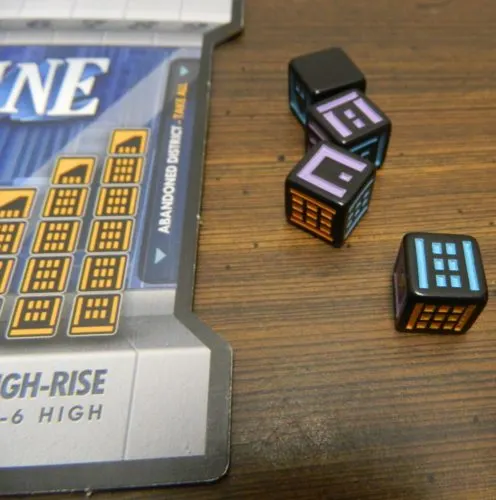
Since there are four dice in the abandoned district, this player has chosen to take the abandoned pile instead of choosing three dice from the construction yard. The abandoned district is replaced with one ground, upper, and penthouse die.
After choosing the dice that they will roll, the player rolls the dice. The player will then have to choose one action to use with one or more of their dice. The player can either build, abandon or demolish with their dice.
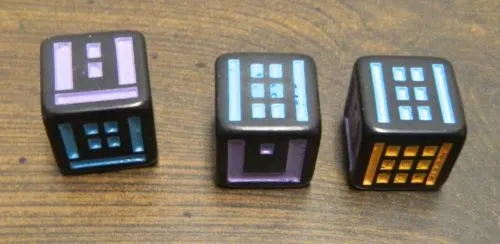
This player decided to take one ground floor and two upper floor dice. They rolled one low-rise/purple ground floor and two mid-rise/blue upper floors. The player can choose to build with the purple dice or they can abandon/demolish with any of the dice.
The first action that a player can use their dice for is to build. To build with dice players take the dice they have chosen to use and add them to their group of buildings. Each building begins with a ground floor. Players can start as many buildings as they want without finishing a building. Players can then add upper floor and penthouse dice on top of a ground floor if the color on the dice match. If a player does not have the corresponding ground floor, a player cannot build with upper floor or penthouse dice of a color.
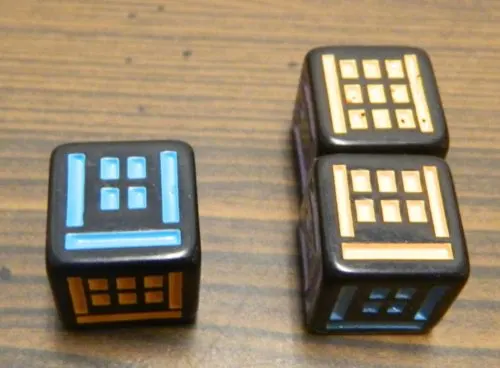
This player rolled three dice on their turn. They rolled a mid-rise ground floor, a high-rise ground floor and a high-rise upper floor. This player decided to build with all three dice.
Some other rules that must be followed when building are as follows:
- Once a dice has been placed it cannot be moved.
- Each additional die added to a building has to be placed above the previously played dice.
- A low-rise building is completed when a ground floor and upper floor are combined together. Mid-rise and high-rise buildings are completed when a penthouse is added to the top after the required number of upper floors have been added. When a building is completed the player takes the corresponding sized building tile and returns the dice to the corresponding construction yard piles.
- A mid-rise building can consist of between two and four floors with one of the floors being the ground floor and one being the penthouse.
- A high-rise building can consist of between three and six floors with one floor being the ground floor and one being the penthouse.
If a player chooses the abandon action they will have to move one or more of their rolled dice to the abandoned district. You can move more than one dice to the abandoned district at a time but there are very few instances where you would want to.
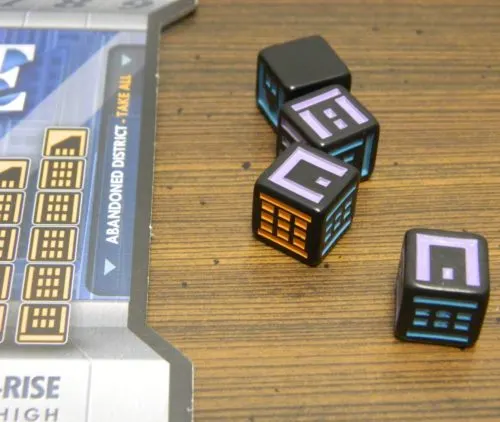
This player was unable to build after their latest roll so they have decided to abandon an upper floor die.
The final action that a player can take is the demolish action. The demolish action allows a player to return one or more of their rolled dice to the construction yard instead of the abandoned district. To use the demolish action though the player has to return all of the dice from one of their buildings to the construction yard. The player can either choose a partially complete or a completed building.
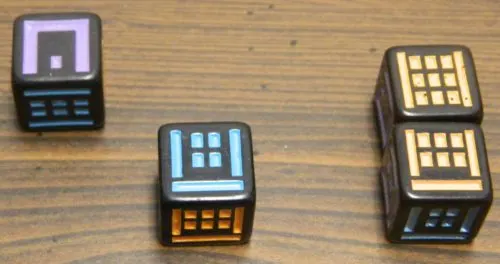
This player rolled a top floor for a low-rise/purple building which they can’t build with. They have decided to demolish their mid-rise/blue building in order to return the purple and blue dice to the construction yard.
After the player has taken an action with one or more of their dice, they have the option to re-roll all of the dice that they haven’t used yet. If the player chooses to re-roll the dice they will only roll the dice they didn’t use and they will have to take an action with at least one of the dice they roll. Otherwise the player can choose to end their turn. If a player decides to end their turn, any dice that they didn’t use are returned to the construction yard.
After a player ends their turn, play passes to the next player clockwise. After all of the players have had their turn this round, the status marker is moved to the next number on the board.
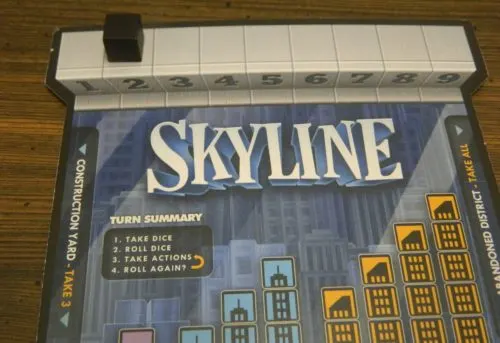
All of the players have completed their first turn so they move the status marker one space to the right.
End of Game
The game ends when one of two things happen:
- All nine rounds have been completed.
- Someone completes a building six dice tall. If the round ends this way, all of the players that haven’t yet had their turn this round will get to complete their turn before the game ends.
Each player counts up how many points they earned during the game. All low-rise/purple buildings are replaced with the one high tall building tiles. All other uncompleted buildings are worth zero points. Players count up the points on all of the building tiles they acquired during the game. The player who scores the most points wins the game. If there is a tie, the player who completed the most buildings breaks the tie.

At the end of the game this player has completed eight buildings and has an unfinished building. The unfinished building is worth zero points. This player scored 95 points.
My Thoughts on Skyline
When players first look at Skyline they may be somewhat intimidated. At first glance Skyline does look a little complicated for a dice game. The game gives players a couple different options of how they can use their dice and all of the dice use custom symbols. The game may seem complicated at first but it really isn’t. Skyline is actually a pretty good introductory designer/hobby game as it introduces some concepts to people that don’t play a lot of board games while still being quite accessible. I can’t see it taking more than maybe five minutes to teach the game to new players. The game may have a recommended age of 10+ but I honestly think kids aged 7-8 should have no trouble with the game as long as they can understand the basic mechanics of how the buildings are created.
On the strategy spectrum I wouldn’t say that Skyline is highly strategic but it still has more strategy than a lot of dice rolling games. The game still relies on a lot of luck (more on this later) but your decisions do have an impact on the game. Your strategy is never going to overcome bad rolls but making the right decisions can help you score more points which ultimately could be the difference between winning or losing the game. I think Skyline’s strategy comes down to a couple factors.
I think the biggest strategic decision in the game is choosing whether to try a build a couple tall buildings or a lot of shorter buildings. Taller buildings give players considerably more points than shorter buildings so each dice used is more valuable. It is considerably harder to build the taller buildings though which makes them considerably riskier. They are riskier for a couple reasons. First since they need more dice it is more likely that you will not be able to finish them before the end of the game. The symbols needed for the taller buildings also appear on less sides of the dice which decreases the odds of you rolling the symbols that you need to complete the buildings. The strategy you pursue is going to somewhat depend on what you roll but you will have to decide whether you want to go with the riskier more lucrative strategy or the safer strategy.
The other area where strategy comes into play is choosing what you are going to do with the dice you roll. If possible you are going to want to build with your dice as each dice you are able to build with will potentially lead to you earning some points. If you are able to build I really can’t see any reason why you would choose one of the other two actions. If you have a couple of dice that you can build with though the decision becomes a little more interesting. While you could build with all of the dice that are eligible, in some situations I could see it being better to re-roll a die instead of settling for what you initially roll. For example if you roll a purple symbol and have other dice that you can build with, you might be better off rolling the purple die again hoping to get a more valuable symbol. Holding off on building with a ground floor die also guarantees that you will be able to build on your next turn.
A much more interesting decision comes out of when you are unable to build. At first I really didn’t understand the difference between the abandon and demolish actions. This is partially because the rules could have done a better job explaining the two actions. Once you start playing the game though you can start to see the difference between the two actions. You would think that the abandon action would be better as you don’t have to destroy one of your buildings. While you can occasionally abandon dice, you cannot always do it or you are giving the other players an advantage in the game as they will get to roll more dice on their turn. It might not make a lot of sense to destroy buildings just to move dice to the construction yard, but in some circumstances it is worth it. If you have a building that is only one die tall, it may be worthwhile to get rid of it in order to prevent another player from getting to roll an extra die. If you regularly abandon dice you are giving the player who plays after you a considerable advantage in the game.
As I will get to shortly Skyline is not a perfect game but I enjoyed the game quite a bit. I kind of wish the game had a little more strategy in relation to the luck but I had fun with Skyline. I think the main reason Skyline works is that it finds a good balance between being accessible while also having some strategy. Outside of really small children I can see everyone enjoying the game and yet it gives players enough decisions where it feels like you are impacting the outcome of the game. Skyline is not the type of game that I will play all of the time but it is a game that I can see bringing out every so often.
While there is a lot that I like about Skyline I would say that the biggest problem that I had with the game is that it is too short. When you first look at Skyline it looks like a more complicated dice rolling game and thus you would think it would take longer than your typical dice rolling game. It turns out that Skyline is actually a pretty short game. The game has an estimated length of 15 minutes which is about right even though it will take a little longer with more players and your first game will take longer as you learn how to play the game. The short length actually does a great job of making Skyline a good filler game. If you don’t have much time you can quickly play a game or you could play several games within an hour.
Another positive with the game being pretty short is that Skyline doesn’t have a lot of player interaction. Just like a lot of dice rolling games, the players have to basically wait around for the other players to complete their turns. A player can’t do anything on another player’s turn that will actually impact the game. Except for players adding dice to the abandoned district, players could play the game by themselves and then compare scores at the end of the game. While I haven’t played the single player game, this is a reason why I think Skyline could work really well as a single player game. While waiting around for the other players is never good, with Skyline being pretty short you don’t have to waste a lot of time waiting for the other players.
Skyline is fine as a filler game but I honestly think it would have been better if it was a little longer. The problem with the game being so short is that you are not given much time to form a strategy. At max you will get nine turns and you likely will only get seven or so turns. That is not a lot of time to form a strategy. Skyline is not a highly strategic game but it would have been nice if the game lasted a little longer so you could have at least tried to implement more of a strategy. In its current state the game feels like it ends almost as soon as it begins.
I think part of the reason that it feels like the game ends kind of suddenly is that in a lot of cases it does. If a player is ever able to complete one of the tallest buildings, the game will end when everyone has completed their turn in the current round. You could be expecting more turns to finish one of your buildings and then the game could end preventing you from finishing one of your buildings. It generally takes quite a few turns in order to finish the tallest building so it will usually only end the game a couple rounds early. The game ending a couple rounds early though could be the difference between winning or losing the game. I would personally think about ignoring this rule and just playing all nine rounds as it won’t make the game much longer and it will let all of the players know how many turns they will have left to finish their buildings.
I had some issues with Skyline being kind of short but the good news is that I don’t think it would be that hard to extend the game. Basically by eliminating the rule that ends the game when the tallest building is built, you can add as many round as you want to the game. I could easily see adding five more rounds to the game and it not making the game that much longer. You might have to worry a little about some of the building tile types running out but otherwise there shouldn’t be any problems with playing more rounds.
Instead of adding more rounds I was also kind of curious how the game would play if players got more dice to roll each turn. Players will occasionally roll more dice if players abandoned some dice but players usually will only roll three dice on their turn. With only three dice to work with most of the time, there is only so much you can do on any given turn. At max you will get two re-rolls and three actions. I think it would be interesting playing with say five dice each turn as it would allow players to do more each turn. This would lead to strategy playing a larger role and would ultimately lead to more points being scored as well. This would only add a little amount of time to the game and I think it could improve the game.
Outside of the game being too short, the other issue I had with Skyline is that it still relies on quite a bit of luck. That is to be expected from a dice game as you are rolling dice after all. There is strategy in choosing which dice to roll and what to do with the dice that you roll. You are still going to rely on rolling the right symbols at the right times though. The player who rolls the best is likely going to win the game. This is especially true when it comes to the taller buildings. Being able to build a tall building in the game gives you a good chance of winning the game. If only one player is able to complete the tallest building they are going to have a very good chance of winning the game.
In general I would say that Skyline has good components but I think there are a few things that could have been improved. For the most part I liked the game’s dice. The game includes 60 custom dice which is quite a few even though there are only three different types of dice. The dice are of a pretty high quality and I appreciate that they are engraved making them much more likely to last over time. I really only had two problems with the dice. First I wish the game could have done something to make the different types of dice easier to distinguish. The only way to distinguish them is by looking at the symbols on the dice. I want to know why the game couldn’t have used different colors, sizes or something else which would have made the three sets of dice much easier to distinguish from one another. The other issue is that some of the symbols on the dice are a little hard to distinguish at times. You eventually get a hang of them but I think some of the ground floor and mid-floor symbols couldn’t have been made a little more distinguishable from one another. Other than the dice I would say the components are quite solid as the artwork is pretty nice and the cardboard is pretty thick.
Should You Buy Skyline?
Skyline is not going to be a game for everyone but I had fun with it. At first it may seem complicated but it really isn’t. The game is really accessible where I think anyone older than like seven or eight should have no trouble playing the game. Skyline still relies on a lot of luck like most dice rolling games but there is also some strategy to the game. Your decisions are not going to overcome bad dice rolls but good decisions could score you a few more points which may be enough to win the game. While I think Skyline works fine as a filler game, my biggest problem with the game is that I think it is too short. You don’t really have enough time to complete any type of detailed strategy and games seem to end almost as soon as they begin. I think the game would be better if it lasted a few more rounds which is easy enough to add with a few rule tweaks.
If you don’t really like dice games Skyline is not going to be for you. If you already have some more complicated dice games that you really enjoy, Skyline may not be for you as it is a little on the simpler side. If you are looking for a more accessible dice rolling game though and you like Skyline’s concept I would look into picking it up.
If you would like to purchase Skyline you can find it online: Amazon, eBay

